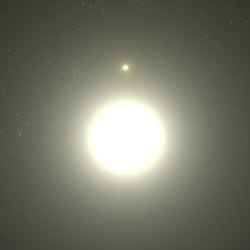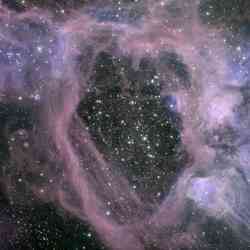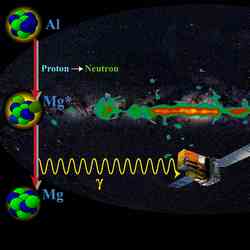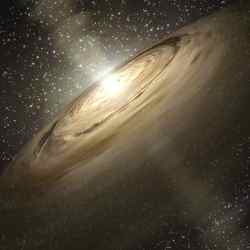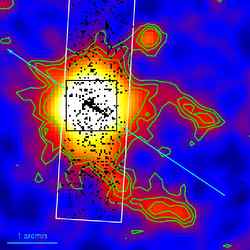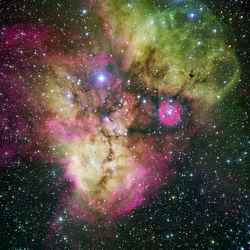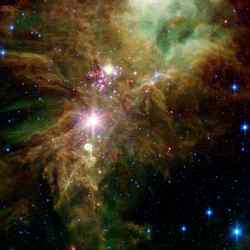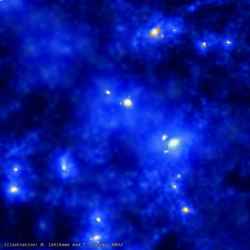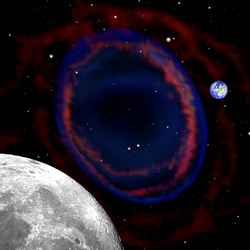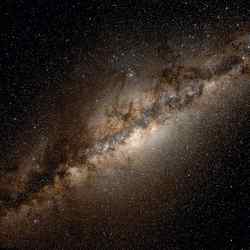
The Milky Way galaxy. Image credit: Serge Brunier. Click to enlarge
The most prominent of the Milky Way’s satellite galaxies – a pair of galaxies called the Magellanic Clouds – appears to be interacting with the Milky Way’s ghostly dark matter to create a mysterious warp in the galactic disk that has puzzled astronomers for half a century.
The warp, seen most clearly in the thin disk of hydrogen gas permeating the galaxy, extends across the entire 200,000-light year diameter of the Milky Way, with the sun and earth sitting somewhere near the crease. Leo Blitz, professor of astronomy at the University of California, Berkeley, and his colleagues, Evan Levine and Carl Heiles, have charted this warp and analyzed it in detail for the first time, based on a new galactic map of hydrogen gas (HI) emissions.
They found that the atomic gas layer is vibrating like a drum, and that the vibration consists almost entirely of three notes, or modes.
Astronomers previously dismissed the Magellanic Clouds – comprised of the Large and Small Magellanic Clouds – as a probable cause of the galactic warp because the galaxies’ combined masses are only 2 percent that of the disk. This mass was thought too small to influence a massive disk equivalent to about 200 billion suns during the clouds’ 1.5 billion-year orbit of the galaxy.
Nevertheless, theorist Martin D. Weinberg, a professor of astronomy at the University of Massachusetts, Amherst, teamed up with Blitz to create a computer model that takes into account the Milky Way’s dark matter, which, though invisible, is 20 times more massive than all visible matter in the galaxy combined. The motion of the clouds through the dark matter creates a wake that enhances their gravitational influence on the disk. When this dark matter is included, the Magellanic Clouds, in their orbit around the Milky Way, very closely reproduce the type of warp observed in the galaxy.
“The model not only produces this warp in the Milky Way, but during the rotation cycle of the Magellanic Clouds around the galaxy, it looks like the Milky Way is flapping in the breeze,” said Blitz, director of UC Berkeley’s Radio Astronomy Laboratory.
“People have been trying to look at what creates this warp for a very long time,” Weinberg said. “Our simulation is still not a perfect fit, but it has a lot of the character of the actual data.”
Levine, a graduate student, will present the results of the work in Washington, D.C., on Jan. 9 during a 10 a.m. session on galactic structure at the American Astronomical Society meeting. Blitz will summarize the work later that day during a 12:30 p.m. press briefing in the Wilson C Room of the Marriott Wardman Park Hotel.
The interaction of the Magellanic Clouds with the dark matter in the galaxy to produce an enigmatic warp in the hydrogen gas layer is reminiscent of the paradox that led to the discovery of dark matter some 35 years ago. As astronomers built better and better telescopes able to measure the velocities of stars and gas in the outer regions of our galaxy, they discovered these stars moving far faster than would be expected from the observed number and mass of stars in the entire Milky Way. Only by invoking a then-heretical notion, that 80 percent of the galaxy’s mass was too dark to see, could astronomers reconcile the velocities with known theories of physics.
Though no one knows the true identity of this dark matter – the current consensus is that it is exotic matter rather than normal stars too dim to see – astronomers are now taking it into account in their simulations of cosmic dynamics, whether to explain the lensing effect galaxies and galaxy clusters have on the light from background galaxies, or to describe the evolution of galaxy clusters in the early universe.
Some physicists, however, have come up an alternative theory of gravity called Modified Newtonian Dynamics, or MOND, that seeks to explain these observations without resorting to belief in a large amount of undetected mass in the universe, like an invisible elephant in the room. Though MOND can explain some things, Weinberg thinks the theory will have a hard time explaining the Milky Way’s warp.
“Without a dark matter halo, the only thing the gas disk can feel is direct gravity from the Magellanic Clouds themselves, which was shown in the 1970s not to work,” he said. “It looks bad for MOND, in this case.”
Because many galaxies have warped disks, similar dynamics might explain them as well. Either way, the researchers say their work suggests that warps provide a way to verify the existence of the dark matter.
The starting point for this research was new spectral data released this past summer about hydrogen’s 21-centimeter emissions in the Milky Way. The survey, the Leiden-Argentina-Bonn or LAB Survey of Galactic HI, merged a northern sky survey conducted by astronomers in the Netherlands (the Leiden/Dwingeloo Survey) with a southern sky survey from the Instituto Argentino de Radioastronom?a. The data were corrected by scientists at the Institute for Radioastronomy of the University of Bonn, Germany.
Blitz, Levine and Heiles, UC Berkeley professor of astronomy, took these data and produced a new, detailed map of the neutral atomic hydrogen in the galaxy. This hydrogen, distributed in a plane with dimensions like those of a compact disk, eventually condenses into molecular clouds that become stellar nurseries.
With map in hand, they were able to mathematically describe the warp as a combination of three different types of vibration: a flapping of the disk’s edge up and down, a sinusoidal vibration like that seen on a drumhead, and a saddle-shaped oscillation. These three “notes” are about 3 million octaves below middle C.
“We found something very surprising, that we could describe the warp by three modes of vibration, or three notes, and only three,” Blitz said, noting that this rather simple mathematical description of the warp had escaped the notice of astronomers since the warp’s discovery in 1957.
“We were actually trying to analyze a more complex ‘scalloping’ structure of the disk, and this simple, elegant vibrational structure just popped out,” Levine added.
The current warp in the gas disk is a combination of these three vibrational modes, leaving one-half of the galactic disk sticking up above the plane of stars and gas, while the other half dips below the disk before rising upward again farther outward from the center of the galaxy. The results of this analysis will be published in an upcoming issue of the Astrophysical Journal.
Weinberg thought he could explain the observed warp dynamically, and used computers to calculate the effect of the Magellanic Clouds orbiting the Milky Way, plowing through the dark matter halo that extends far out into the orbit of the clouds.
What he and Blitz found is that the clouds’ wake through the dark matter excites a vibration or resonance at the center of the dark matter halo, which in turn makes the disk embedded in the halo oscillate strongly in three distinct modes. The combined motion during a 1.5-billion-year orbit of the Magellanic Clouds is reminiscent of the edges of a tablecloth flapping in the wind, since the center of the disk is pinned down.
“We often think of the warp as being static, but this simulation shows that it is very dynamic,” Blitz said.
Blitz, Levine and Heiles are continuing their search for anomalies in the structure of the Milky Way’s disk. Weinberg hopes to use the UC Berkeley group’s data and analysis to determine the shape of the dark matter halo of the Milky Way.
The research of the UC Berkeley group is supported by the National Science Foundation. Weinberg is partly supported by NASA and the NSF.
Original Source: UC Berkeley News Release
